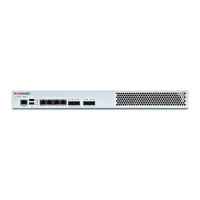How to set up your FortiWAN Configuring Network Interface (Network Setting)
RIP
FortiWAN supports the Routing Information Protocol (RIP v1, v2), RIP employs hot count as the metric, and uses timer
broadcast to update the router. As RIP features configuration simplicity and operation convenience, it has been widely
used across all fields. RIP version 1 (v1)1 was designed to suit the dynamic routing needs of LAN technology-based IP
internetworks, and to address some problems associated with RIP v1, a refined RIP, RIP version 2 (v2) was defined.
RIP v2 supports sending RIP announcements to the IP multicast address and supports the use of authentication
mechanisms to verify the origin of incoming RIP announcements.
Check the field in [RIP] if you have enabled RIP on your private subnet router. Check the field in [RIP v1] if you have
enabled RIP v1 on your private subnet router behind FortiWAN. Thus, FortiWAN can forward packets from the RIP v1-
enabled private subnet. Otherwise, check the field in [RIP v2] if you have enabled RIP v2 on your private subnet router.
Thus, FortiWAN can forward RIP v2 packets. Moreover, if you have enabled RIP v2 authentication, type the password
in [Password]. Otherwise, keep [Password] blank.
OSPF
Apart from RIP, FortiWAN also supports OSPF (Open Shortest Path First), to assign LAN port router with given
preference. Like RIP, OSPF is designated by the Internet Engineering Task Force (IETF) as one of several Interior
Gateway Protocols (IGPs). Rather than simply counting the number of hops, OSPF bases its path descriptions on "link
states" that take into account additional network information. Using OSPF, a host that obtains a change to a routing
table or detects a change in the network immediately multicasts the information to all other hosts in the network so
that all will have the same routing table information.
OSPF Interface :
Displays the LAN port in the network. Check the box to enable OSPF over
the port.
51 FortiWAN Handbook
Fortinet Technologies Inc.

